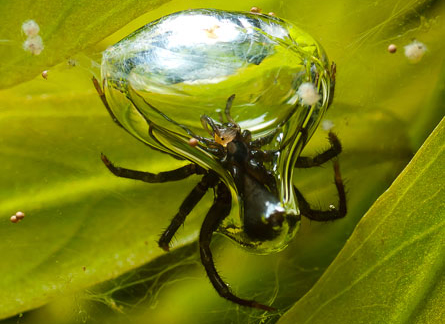- More than 2 years ago
In Germany’s Eider River, spiders not only swim with the fishes, they kind of breathe like them, too.

Eurasian diving bell spiders (Argyroneta aquatica) survive entirely underwater by living in large air bubbles, which the crawlers trap in silken webs. A new study shows that these bubbles work like a “physical gill,” drawing oxygen in from the water to match much of the spider’s consumption. Researchers from Australia and Germany report their findings in the July Journal of Experimental Biology.
For insects, physical gills are nothing new. Certain small bugs bob and dive into streams and rivers with the help of plastrons, trapped films of air that coat their bodies. As the bugs consume this trapped oxygen, gas diffuses in from the surrounding water, replenishing the supply, says Morris Flynn, a mechanical engineer at the University of Alberta in Canada. In contrast, diving bell spiders seem to actively replenish their air bubble – called a diving bell after the antique submarines – by frequently traveling to the surface to grab more oxygen. They trap the air between their back legs and abdomens, later adding it to the bell. This keeps the diving bell from collapsing.
But scientists didn’t know if the diving bell spiders’ diving bells, which the crawlers can leave behind while they go grab food or find a mate, were anything but scuba tanks, holding a one-time supply of air.
It turns out that, like plastrons, the diving bells behave like gills too. Roger Seymour of the University of Adelaide in Australia and Stefan Hetz from Humboldt University of Berlin discovered. At least five times the original supply of oxygen can diffuse into an occupied bell throughout the bell’s lifetime, Seymour says. Using tiny oxygen probes, the team discovered that the oxygen coming into the bell may, at times, match a resting spider’s consumption. By estimating the oxygen needs of a spider resting in an average-sized bell, “we showed that the spider was quite happy for more than a day,” Seymour says. In fact, the bells’ endurance seems to be largely limited by nitrogen rather than oxygen, he adds. Nitrogen gas slowly leaks out of the bubbles like helium from a helium balloon, leading to collapse.
Diving spiders may have to visit the surface more than daily, however, since they do more than rest. In this study, the team observed that before dining on insects captured in underwater webs — an energy-intensive feat — spiders paddled to the surface to squirrel away more air.
The diving bell’s gill-like properties do, nevertheless, mean that spiders can stay safely in their bubbles for longer. The open water is a dangerous place filled with predatory fish and insects, all better swimmers than the spider, says Michael Taborsky, a behavioral ecologist at the University of Bern in Switzerland. “When they have to go to the surface to replenish their oxygen preserves,” Taborsky says, “this is the dangerous side.”
Diving bells may have their limitations, but insect plastrons could inspire submersible designs, Flynn says. Some researchers have already proposed contouring small underwater crafts so that their fuel cells collect similar gills, providing the machines with a continuous supply of oxygen.





